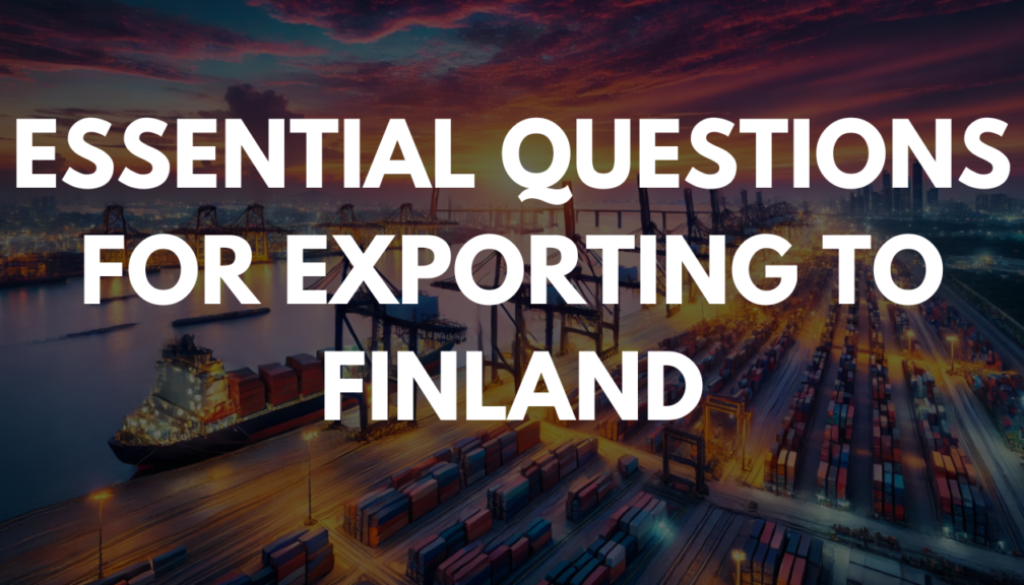Essential Questions for Exporting to Finland
Last Updated on 15. Nov 2024 by b2bexport
Are you considering expanding your business by exporting to Finland?
Venturing into foreign markets like the Finnish market might seem overwhelming, but with the right information, it can be a smooth and successful journey. Export regulations play a crucial role in this process, impacting how goods and services are exchanged between countries.
Exporting involves selling goods or services to another country, making it an essential aspect of global commerce.
Understanding the definition of exporting is the first step towards entering foreign markets. Finland, with its strategic location in Northern Europe and membership in the European Union, offers significant opportunities for businesses looking to export products to Finland. Here, we address the top ten questions about exporting to Finland, providing comprehensive insights into taxes, regulations, payment options, standards, and certifications.
This guide is designed to make your entry into this new market straightforward and stress-free..
1. What Are the Main Export Products to Finland?
Finland’s diverse import market includes a wide range of products that cater to its industrial and consumer needs, making it a significant export market for various countries.
Understanding the primary export market products to Finland is essential for businesses aiming to tap into this dynamic market.
Machinery and Equipment: This category includes electronics, computers, telecommunications equipment, and machinery for various industries such as manufacturing and agriculture.
These products are essential for Finland’s industrial and technological sectors. Countries exporting machinery and equipment to Finland include other Nordic countries, European countries, and nations from Northern Europe and Western Europe.
Chemicals and Plastics: Finland imports a range of chemical products, including pharmaceuticals, paints, and fertilizers, which are crucial for its healthcare, construction, and agricultural sectors.
Exporting countries for chemicals and plastics often face common foreign trade barriers and must ensure compliance with Finland’s strict import regulations.
Wood and Paper Products: As a country with a significant forest industry, Finland imports pulp, paper, and various wood-based products for its domestic production needs.
This sector benefits from the export products of other Nordic countries and Northern Europe, where similar forest industries exist.
Metals and Metal Products: Imports include iron, steel, and various metal-based products essential for construction, manufacturing, and other industrial applications.
Countries from Eastern Europe and Western Europe are significant exporters of metals and metal products to Finland, often dealing with foreign currency transactions and direct exporting methods.
Food and Beverages: Due to its relatively small agricultural sector, Finland imports dairy products, meat, fish, and alcoholic beverages to meet domestic demand.
Exporting countries for food and beverages must navigate trade barriers, including sanitary and phytosanitary measures, to ensure their products meet Finnish standards.
Textiles and Clothing: This includes fabrics, clothing, and accessories, which are important for the fashion and retail markets in Finland.
Exporters from countries with strong textile industries, such as those in Eastern Europe and other parts of Europe, provide these goods, often dealing with issues like cultural differences and foreign competition.
Vehicles and Transport Equipment: Imports include cars, trucks, and aircraft, supporting Finland’s transportation infrastructure and mobility needs.
Countries like Germany and the United Kingdom are major exporters in this category, facing challenges such as government-imposed measures and varying environmental regulations.
Energy Products: Finland imports oil and gas to supplement its energy requirements, particularly for heating and industrial processes.
Exporting countries, including Russia and Norway, play a crucial role in meeting Finland’s energy needs, navigating complexities related to international exchange and foreign currency transactions.
Minerals and Mineral Products: These include industrial minerals such as iron ore, which are used in various manufacturing processes. Exporters from regions rich in natural resources, such as Eastern Europe and Northern Europe, contribute to Finland’s mineral imports.
Environmental and Sustainable Products: This category includes renewable energy technologies and environmental monitoring equipment, reflecting Finland’s commitment to sustainability and environmental protection.
Exporting countries focusing on green technologies often deal with lower export prices and trade barriers related to environmental regulations.
Raw Materials: Finland’s industrial sector relies on the import of raw materials, including metals, chemicals, and minerals, to support manufacturing processes.
Exporting countries must ensure compliance with Finnish import regulations, including customs duties and taxes.
Exported Goods: Finland also imports a variety of finished and semi-finished goods, such as machinery, electronics, and consumer products.
Countries exporting these goods must consider the import regulations, product standards, and labeling requirements imposed by Finland.
By understanding these key export market products and the associated trade dynamics, businesses can effectively navigate the Finnish market. Whether dealing with direct exporting, government-imposed measures, or cultural differences, successful exporters recognize the importance of adapting to Finland’s specific market needs.
2. What Are the Import Regulations for Products Entering Finland?
Finland maintains strict import regulations and government-imposed measures to ensure product safety and compliance with local laws.
Customs Duties and Taxes: These are charges applied to imported goods, which vary based on the product category and country of origin.
It’s important to check the specific rates for your products.
Product Safety and Labeling: Imported products must meet Finnish safety standards and labeling requirements, which may involve specific testing and certification processes.
Sanitary and Phytosanitary (SPS) Requirements: Products of animal and plant origin must comply with SPS measures to prevent the introduction of diseases or pests.
This can include requirements for inspection, certification, and possible quarantine.
Environmental Regulations: Certain products are subject to environmental regulations, such as restrictions on hazardous substances and requirements for energy efficiency.
Intellectual Property Rights: Imported products must not infringe on existing intellectual property rights in Finland, such as trademarks, patents, or copyrights.
Proper registration and verification are crucial.
Consult with Finnish customs or relevant authorities to confirm specific requirements for your products.

3. What Documentation Is Required for Exporting to Finland?
Exporting to Finland requires various documents, including foreign currency considerations.
Commercial Invoice: This document provides detailed information about the goods being shipped, including their quantity, value, and description, which is necessary for customs clearance.
Packing List: This lists the contents of each package being shipped, including weight, dimensions, and the number of packages, helping customs officials verify the shipment details.
Bill of Lading: A document issued by the carrier to acknowledge receipt of the goods, which serves as proof of ownership and details the terms of shipment.
Certificate of Origin: This certifies the country in which the goods were manufactured and is often required for customs clearance to determine tariffs and duties.
Export License: Certain products may require an export license issued by the relevant authorities in the country of origin, especially if they are controlled goods.
Insurance Certificate: This provides proof of insurance coverage for the goods during transit, protecting against potential losses or damages.
Pro Forma Invoice: A preliminary invoice that outlines the estimated cost of the goods being shipped, often used in the early stages of negotiation and order confirmation.
Import Permits: Some products, such as food, pharmaceuticals, and chemicals, may require specific import permits from Finnish authorities.
Ensure all necessary documents are provided to avoid delays and compliance issues.
4. What Are the Taxes and Duties Associated with Exporting to Finland?
When exporting to foreign countries like Finland, be aware of various taxes and duties.
Value-Added Tax (VAT): VAT is applied to the price of goods, including transportation costs.
The standard rate in Finland is 24%, but reduced rates of 10% and 14% apply to specific goods like food and books.
Customs Duties: These are taxes on goods imported from outside the EU.
The duty rate depends on the type of product, its value, and its country of origin.
Excise Duties: Applied to certain goods such as alcohol, tobacco, and energy products, with rates varying based on the product type.
Environmental Taxes: Certain products like tires, lubricants, and electronic equipment are subject to environmental taxes aimed at promoting sustainability.
Consult with Finnish customs authorities or a customs broker for accurate information on applicable taxes and duties.

5. What Are the Logistics and Transportation Options for Exporting to Finland?
Consider these transportation options for direct exporting:
Road Transport: Ideal for goods from neighboring European countries, utilizing Finland’s well-maintained road network and major highways.
Sea Freight: A popular choice for global shipments, with major ports in Helsinki, Turku, and Kotka providing access to international shipping routes.
Air Freight: The fastest mode of transport, suitable for high-value or time-sensitive goods, with Helsinki-Vantaa airport being the main hub.
Rail Transport: Though less common, rail transport is cost-effective for specific products, connecting Finland with other European countries.
Multimodal Transport: Combining different modes of transport (e.g., sea and road) for efficiency and cost-effectiveness, depending on the product and destination.
Choose the option that best suits your product type, delivery requirements, and destination.
6. What Are the Cultural Norms and Business Practices in Finland That Could Affect Exporting?
Understanding Finnish culture and business practices is crucial, especially when navigating trade barriers and legal regulations for exporting to Finland.
Punctuality and Efficiency: Meetings start and end on time, with a strong emphasis on productivity and efficiency in business dealings.
Direct Communication: Finns appreciate honesty and directness in communication, avoiding overly emotional or confrontational language.
Personal Space: Respect for personal space and privacy is important, with Finns generally being reserved in social interactions.
Trust and Reliability: Building trust takes time, but it is essential for long-term business relationships. Honesty and dependability are highly valued.
Sustainability: Environmental responsibility is a priority in Finland, with businesses often focusing on eco-friendly practices and products.
Technology and Innovation: Finnish businesses are early adopters of new technologies and innovations, making it important to stay updated with the latest trends.
Respect these norms to build strong business relationships.

7. How Can I Find Potential Buyers and Distributors in Finland?
Explore these avenues to find potential buyers and distributors:
Online Directories: Utilize listings from the Finland Chamber of Commerce, Finnish Business Angels Network, and other business networks to identify potential partners.
Trade Shows: Attend events such as the Helsinki International Boat Show, Helsinki Food Fair, and Helsinki Book Fair to meet potential buyers and distributors.
Government Agencies: Seek support from Business Finland and the Finnish Trade Promotion Agency, which provide information and connect businesses with Finnish companies.
Industry Associations: Engage with associations like the Finnish Forest Industries Federation for sector-specific contacts and information.
Online Marketplaces: Platforms like Amazon, eBay, and Alibaba allow you to list products and connect with potential buyers and distributors in Finland.
Conduct due diligence to evaluate potential partners thoroughly, considering common foreign trade barriers such as government-imposed measures, extra costs, and complex payment collection methods.
8. What Are the Legal and Regulatory Requirements for Exporting to Finland?
Ensure compliance with:
Customs Regulations: Adhere to customs rules, including obtaining export licenses and paying relevant tariffs.
Product Standards: Meet Finnish standards for product labeling, safety, and environmental compliance.
Intellectual Property Laws: Protect trademarks, patents, and copyrights, ensuring products do not infringe on existing IP rights.
Contractual Obligations: Follow through on payment terms, delivery schedules, and warranties.
Data Protection: Comply with Finnish data protection regulations for handling personal data.
Environmental Regulations: Align with sustainability practices and environmental protection laws.
Seek legal and regulatory expertise to ensure compliance.
9. What Are the Language Requirements for Business Communications in Finland?
Finnish and Swedish are official languages, with English widely spoken. Consider:
Language Proficiency: If necessary, hire translators to ensure accurate communication.
Written Communication: Translate business documents into Finnish or Swedish, ensuring proper spelling, grammar, and punctuation.
Verbal Communication: Use appropriate titles and formal language when meeting with Finnish businesspeople.
Cultural Sensitivity: Respect Finnish cultural norms, valuing punctuality and direct communication while avoiding confrontational language.
Effective communication can strengthen business relationships.
10. How Can I Protect My Intellectual Property When Exporting to Finland?
Safeguard your IP by:
Registering Your IP: Obtain legal protection by registering trademarks, patents, and copyrights with Finnish authorities.
Monitoring for Infringement: Regularly search for unauthorized use of your IP, particularly in online marketplaces and local businesses.
Enforcing Your Rights: Take legal action if necessary, including sending cease and desist letters and pursuing litigation.
Collaborating with Local Partners: Work with Finnish partners to understand the local IP landscape and identify potential infringements.
Educating Employees: Provide guidelines for protecting IP and preventing unintentional infringements within your organization.
Combine proactive and reactive measures to protect your IP.
Conclusion
Exporting to Finland offers significant opportunities for businesses aiming to expand into foreign markets.
By understanding the main export products, import regulations, required documentation, and taxes, you can confidently navigate this market. Awareness of Finland’s logistics options, cultural norms, and legal requirements ensures smooth operations. Finding potential buyers and distributors, and protecting your intellectual property, are essential for establishing a presence in Finland.
Leveraging the insights from this guide helps you make informed decisions and build strong business relationships.
Net exports significantly impact a country’s economic well-being, highlighting the importance of measuring and understanding their effects. The Finnish market is known for innovation, sustainability, and reliability, making it an attractive destination for exporters. Ready to take the next step?




